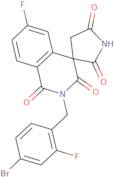Produktinformation
- 2-(4-Bromo-2-fluorobenzyl)-6-fluorospiro(isoquinoline-4(1H),3'-pyrrolidine)-1,2',3,5'(2H)-tetrone
- 2-(4-bromo-2-fluorobenzyl)-6-fluoro-1H,2'H,5'H-spiro[isoquinoline-4,3'-pyrrolidine]-1,2',3,5'(2H)-tetrone
- 2-[(4-Bromo-2-fluorophenyl)methyl]-6-fluorospiro[isoquinoline-4(1H),3′-pyrrolidine]-1,2′,3,5′(2H)-tetrone
- Ari 509
- Minalrestat [USAN:INN]
- Spiro(isoquinoline-4(1H),3'-pyrrolidine)-1,2',3,5'(2H)-tetrone, 2-((4-bromo-2-fluorophenyl)-methyl)-6-fluoro-
- Spiro[isoquinoline-4(1H),3′-pyrrolidine]-1,2′,3,5′(2H)-tetrone, 2-[(4-bromo-2-fluorophenyl)methyl]-6-fluoro-
- Unii-G44Pe6Qb31
- Way-Ari-509
Minalrestat is a drug that has been approved for use in humans to treat type 2 diabetes. It is an inhibitor of hormone-sensitive lipase and has shown a hypoglycemic effect in diabetic animals. Minalrestat binds to the protein target, which is essential for the regulation of blood glucose levels. The drug has been shown to be effective against diabetic neuropathy and congestive heart disease. Minalrestat is not metabolized by the liver or kidneys, which allows it to be used safely in patients with renal or hepatic dysfunction, as well as those who are pregnant or breastfeeding. Minalrestat can also be administered orally, intravenously, or subcutaneously and its pharmacokinetic properties have been studied extensively in both humans and animals.
Minalrestat increases insulin sensitivity by binding to the insulin receptor on cells without activating it directly. It also inhibits glucose uptake into cells by blocking the transporter GLUT4 at physiological concentrations. This binding prevents insulin from being





